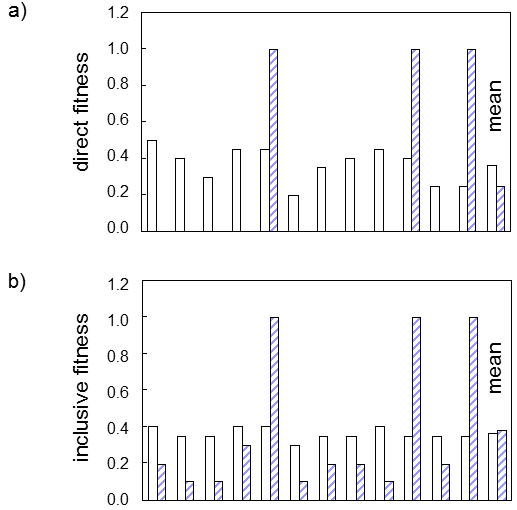VII.1.2 Many species invest what may seem a disproportionately large part of their reproductive capacity into producing migrants.
In many species, the production of migrants is a costly investment that may not seem very efficient. Many migrants die without offspring, many reach locations that are less favourable in terms of chances for survival. Hamilton (Hamilton & May 1977; Comins, Hamilton, & May 1980) (Fig. VII.2) suggested

Fig. VII.2 Migrants’ contribution to individual biological fitness. The height of the bars shows the values of direct (a) and inclusive (b) fitness arising from the production of normal offspring (empty bars) and migrants (shaded bars) for thirteen members of a hypothetical population. In case of direct fitness, most migrants exhibit zero biological fitness, i.e. they will never breed, yet some will achieve superior fitness. In real populations, the frequency of successful migrants can be far lower, so we might encounter them in field research at all. When estimating biological fitness on the basis of inclusive fitness, the differences between normal offspring and migrants become rather smaller. If normal individuals remain near the place where they were born, they will most probably compete with their relatives and thus reduce their own inclusive fitness. On the other hand, the departure of migrants who will not breed increases the resources available for their relatives and thus enhances the migrants’ inclusive fitness.
reasons why many species nevertheless invest a large part of their reproduction potential into producing migrants. By moving farther away from their parents, migrants reduce the chance of offspring competing with their own family. This situation is extremely beneficial from the point of view of individual inclusive fitness. Thus, an allele “programming” its bearer to produce primarily migrants will be preferred in interallelic competition over an allele reducing the number of migrants produced in favour of production of non-migrant offspring. Another advantage of investing in migrants lies in the fact that migrants have a non-zero chance of reaching an unoccupied location and also in the exponential rise of the newly established population producing more offspring in subsequent generations than the non-migrating individuals under the possibly better conditions in the territory of the parent sub-population, which, however, is already occupied by the species.
